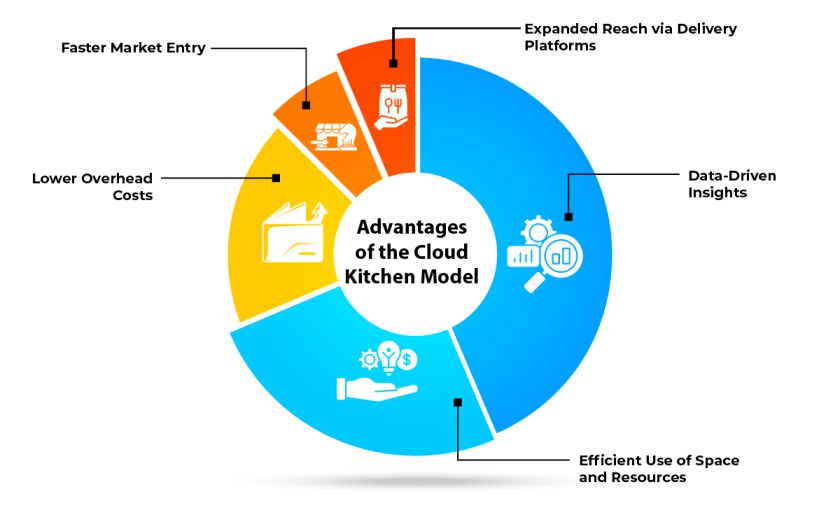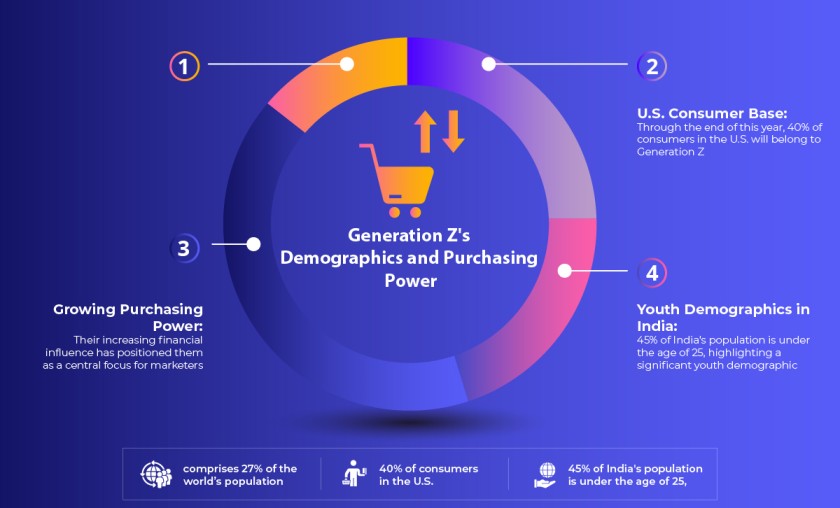Cloud kitchens, also known as ghost or virtual kitchens, have revolutionized the food delivery industry, reshaping restaurant operations and consumer dining experiences. These kitchens focus solely on preparing food for online orders, eliminating the need for traditional dining spaces. Through leveraging technology, cloud kitchens streamline food preparation and delivery, offering a more efficient and cost-effective solution for restaurateurs.
This approach represents a fundamental shift in food service, providing flexibility for chefs to experiment with new dishes while minimizing overhead costs. Cloud kitchens cater to the growing demand for convenient, high-quality food, driven by changing consumer habits and the rise of food delivery platforms.
The rise in online food orders, particularly in metropolitan areas, along with the convenience provided by food aggregators such as Swiggy and Zomato, are significant growth drivers. As the industry evolves, cloud kitchens are increasingly integral to the food service sector, creating new opportunities for culinary innovation and business expansion.
The global cloud kitchen market, valued at USD 44.70 billion in 2023 and projected to reach USD 95.82 billion by 2031. Unlock trends and expert insights with Data Bridge Market Research. Explore your market potential today!
https://www.databridgemarketresearch.com/reports/global-cloud-kitchen-market
Understanding Cloud Kitchen
At their core, cloud kitchens are commercial kitchen spaces designed to prepare food exclusively for delivery. Unlike traditional restaurants, they do not have a physical dining area for customers. Instead, these kitchens focus on fulfilling online orders from delivery platforms such as Uber Eats, DoorDash, and Grubhub. This business model allows chefs and entrepreneurs to reduce overhead costs related to rent, utilities, and staff while reaching a broader audience through digital platforms.
The cloud kitchen concept offers several advantages over conventional restaurant operations. For starters, it allows for greater flexibility in menu creation and pricing. Chefs can experiment with different cuisines or concepts without the constraints of a traditional dining experience. If a particular dish does not resonate with customers, it can be easily modified or removed from the menu. This adaptability has attracted a new generation of culinary entrepreneurs eager to test their ideas in the market. For instance, in July 2023, Rebel Foods, a global leader in the cloud kitchen industry, entered the Saudi Arabian market by launching two cloud kitchens in Riyadh. With plans to establish 60 internet restaurants within the city over the next year, the move highlights Rebel Foods' ambition to tap into Saudi Arabia’s fast-growing food delivery market. This expansion marks a strategic step towards dominating the Middle Eastern online food industry.
The Technology Backbone
Technology plays a crucial role in the rise of cloud kitchens. The integration of advanced software solutions has streamlined various aspects of food preparation and delivery. For instance, online ordering platforms have sophisticated algorithms that optimize delivery routes, ensuring that food arrives at the customer’s door as fresh and hot as possible. In addition, kitchen management systems help track inventory, monitor food safety standards, and manage employee schedules.
Moreover, the use of data analytics allows cloud kitchen operators to gain valuable insights into customer preferences and ordering habits. Through analyzing this data, businesses can tailor their menus to meet evolving consumer demands. If a particular dish becomes popular, operators can ramp up production to meet increased demand, minimizing waste and maximizing profit.
The Culinary Experience Redefined
Cloud kitchens are not just changing the operational side of food service; they are also redefining the culinary experience for consumers. With a focus on delivery, these kitchens are breaking down geographical barriers. Customers can now enjoy a diverse range of cuisines from the comfort of their homes, with options that were once limited to specific locations.
This shift has led to the emergence of culinary brands that cater to niche markets. For instance, a cloud kitchen may specialize in vegan comfort food, gourmet burgers, or ethnic cuisine that might not have a significant presence in the local dining scene. The result is an explosion of culinary diversity that enriches the food delivery landscape. For instance, In March 2022, Just Eat Takeaway, Europe's leading online food ordering and delivery service, partnered with McDonald's to enhance its delivery reach. This strategic alliance aimed to capitalize on the rising demand for food delivery services across Europe. Through working together, both companies planned to streamline operations, improve delivery times, and cater to the growing consumer preference for fast, reliable delivery of McDonald's offerings through Just Eat Takeaway expansive platform.
The Impact of COVID-19
The COVID-19 pandemic significantly accelerated the rise of cloud kitchens as traditional restaurants struggled with lockdowns and social distancing measures. With dining rooms forced to close, many restaurants shifted to delivery-only models, leveraging cloud kitchens to stay operational. The pandemic underscored the vulnerability of traditional dining establishments and created an urgent need for innovation in the food industry. As demand for food delivery surged, many restaurants adapted their business strategies, exploring partnerships with cloud kitchens to meet growing consumer needs.
Globally, the restaurant industry faced enormous disruption, with 144 million workers affected and 95% of restaurants forced to close (WHO, 2020; UN News, 2020). The industry, comprising around 1 million workers, dealt with unprecedented challenges. Amid this crisis, embracing elements of the creative economy became crucial for survival. Cloud kitchens emerged as a highly adaptive solution, offering restaurants a streamlined, cost-efficient way to focus on delivery while reducing overhead costs associated with traditional dining spaces.
The Benefits of Cloud Kitchens
- Lower Overhead Costs: Cloud kitchens eliminate the need for physical dining spaces, reducing expenses related to rent, utilities, and front-of-house staff. This cost-efficiency allows food businesses to operate with smaller budgets while focusing on food production and quality, ultimately increasing profitability
- Faster Market Entry: Without the need to establish a traditional restaurant, cloud kitchens enable food entrepreneurs to enter the market quickly. This rapid setup allows them to capitalize on new trends or unmet demand, providing a competitive edge in the fast-paced food industry
- Expanded Reach via Delivery Platforms: Cloud kitchens leverage third-party delivery platforms to access a broader customer base. Through partnering with platforms such as Uber Eats, DoorDash, or Grubhub, cloud kitchens can reach customers across vast geographical areas, far beyond the limits of a brick-and-mortar location
- Data-Driven Insights: Cloud kitchens rely heavily on technology and data analytics to optimize operations. Through tracking customer preferences and sales patterns, operators can make informed decisions about menu adjustments, ingredient sourcing, and marketing strategies, improving customer satisfaction and business performance
- Efficient Use of Space and Resources: Operating purely as a kitchen allows cloud kitchens to use their space efficiently, focusing solely on food preparation. This specialization optimizes workflow, reduces waste, and allows for better control over quality and consistency, essential for a delivery-focused business model
Challenges and Considerations
While cloud kitchens present exciting opportunities, they also come with their own set of challenges. One major hurdle is the reliance on third-party delivery services. While these platforms provide access to a vast customer base, they also take a significant cut from each order. This can impact profit margins, especially for smaller operators.
In addition, maintaining food quality during delivery is crucial. Unlike traditional dining experiences, where food is served immediately, cloud kitchens must ensure that meals remain fresh and hot during transit. This requires strategic packaging solutions and careful planning of delivery times.
Moreover, the crowded market of cloud kitchens has led to increased competition. As more entrepreneurs enter this space, standing out requires effective branding and marketing strategies. Building a loyal customer base in such a dynamic environment can be challenging, necessitating continuous engagement and innovation.
The Future of Cloud Kitchens
As consumer preferences evolve, cloud kitchens are becoming a vital part of the food service landscape. The rise of remote work and shifting dining habits has made convenience and accessibility more important than ever. Generation Z, also known as Post-Millennials, plays a key role in this transformation. Tech-savvy and health-conscious, this generation frequently shares lifestyle information through social media and follows influencers who promote green behaviors. With 27% of the world’s population falling under Generation Z, their growing purchasing power has made them a central focus for marketers. In India, 45% of the population is under 25, and by the end of this year, 40% of U.S. consumers will belong to Generation Z.
Open-minded and innovation-driven, Generation Z embraces e-shopping more than Millennials and is less brand-loyal. They are tech enthusiasts and regularly use electronic gadgets. In addition, they value meaningful causes and prefer to contribute in creative ways, seeking personal fulfillment rather than traditional forms of community involvement.
As this generation shapes future consumer trends, cloud kitchens are possibly to specialize further. Health-focused meals, sustainable dining, and culturally inspired cuisine could become more popular as Generation Z demands diverse and unique options. Moreover, technology advancements, including artificial intelligence and robotics, are expected to streamline cloud kitchen operations, improving efficiency and enhancing the overall dining experience. This evolution will allow cloud kitchens to cater to an increasingly diverse and demanding audience.
Conclusion
The rise of cloud kitchens represents a paradigm shift in the food delivery landscape, revolutionizing how we experience dining. With their innovative approach to culinary creativity, cost efficiency, and adaptability, cloud kitchens have emerged as a compelling alternative to traditional restaurants. As they continue to evolve and reshape consumer expectations, these kitchens are not just serving meals; they are redefining the future of food. For instance, In January 2024, ITC announced its plans to extend its cloud kitchen business by penetrating major cities such as Mumbai, Delhi, and Kolkata. The company’s business model involves a central kitchen supported by several satellite kitchens, designed to be in proximity to customers. This strategy aligns with delivery platforms including Swiggy and Zomato, which prefer cloud kitchens located every 2.5 to 3 km to ensure faster delivery and better customer service.
The integration of technology, coupled with a focus on diverse culinary offerings, has opened new doors for entrepreneurs and consumers. As the food delivery landscape continues to evolve, cloud kitchens will play a pivotal role in shaping the future of dining experiences, catering to a growing demand for convenience, variety, and quality. Whether it's through unique culinary concepts or advanced operational strategies, the impact of cloud kitchens is set to resonate for years to come, offering exciting possibilities for the food industry and consumers.












